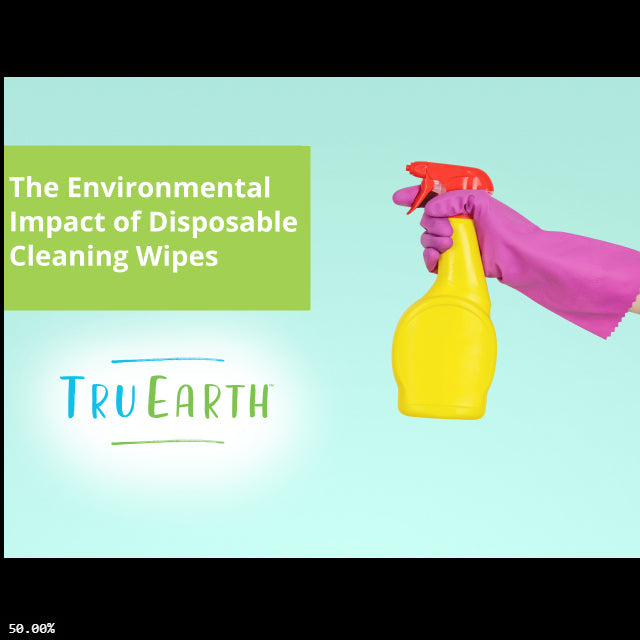Wegwerpreinigingsdoekjes zijn een handige manier om snel oppervlakken te reinigen en te desinfecteren. Het gebruik van deze producten is echter steeds populairder geworden, wat belangrijke vragen oproept over hun impact op het milieu.
Hoewel wegwerpdoekjes een gemakkelijke en efficiënte oplossing bieden voor dagelijkse rommel, dragen ze helaas aanzienlijk bij aan plasticvervuiling en afval op de stortplaats. Dit artikel onderzoekt de milieueffecten van wegwerpdoekjes en wat er gedaan kan worden om over te stappen op een groenere manier van schoonmaken.

Wat zijn vochtige doekjes?
Vochtige doekjes zijn in veel huishoudens onmisbaar geworden en hun populariteit is de afgelopen twee decennia enorm toegenomen. Of ze nu worden gebruikt voor het reinigen van oppervlakken of handen, babyverzorging, vrouwelijke hygiëne of huidverzorging - vochtige doekjes zijn een handige manier om snel en gemakkelijk schoon te worden in bijna elke situatie.
Bijna 90% van de vochtige doekjes is gemaakt van kunstmatige materialen zoals polyester, rayon, lyocell en viscose. De uitvinding ervan dateert uit 1958 in de Verenigde Staten en er worden nu dagelijks miljarden vochtige doekjes over de hele wereld gebruikt.
Tijdens de coronapandemie is het gebruik van antibacteriële en gewone vochtige doekjes enorm toegenomen. Mensen zochten naar manieren om openbare oppervlakken effectiever te ontsmetten.
Ook kopen nieuwe ouders vaak een voorraadje babydoekjes in met daarop specifieke merken vochtige doekjes die aloë vera en andere milde ingrediënten bevatten. Deze kunnen veilig worden gebruikt op de gevoelige huid van hun kind, zonder irritatie te veroorzaken.
Met zoveel toepassingsmogelijkheden is het geen wonder dat vochtige doekjes wereldwijd een vast onderdeel van het huishouden zijn geworden.
Waarom worden vochtige doekjes als slecht beschouwd?
Vochtige doekjes vormen een milieurisico met verstrekkende gevolgen. Ze bevatten niet alleen plastic en andere niet-biologisch afbreekbare materialen, maar wanneer deze plastics afbreken tot microplastics , kunnen ze in de voedselketen terechtkomen en hele ecosystemen ontwrichten.
Bovendien wordt 93% van de verstoppingen in de riolering van huishoudens veroorzaakt door vochtige doekjes. Daarom is het zo belangrijk om zorgvuldig om te gaan met het weggooien van vochtige doekjes en waar mogelijk te zoeken naar biologisch afbreekbare alternatieven.

Wat is de impact op het milieu?
Vochtige doekjes bestaan niet alleen uit niet-biologisch afbreekbare plastic vezels, die waterwegen en stortplaatsen vervuilen, maar de onjuiste afvoer ervan kost landen jaarlijks miljoenen dollars. Het grootste deel van deze kosten komt voort uit het ontstoppen van riolen die verstopt zijn geraakt met vochtige doekjes.
Sinds het midden van de jaren 2000 is het lozen van afval in het toilet een alarmerend fenomeen geworden. Sindsdien is het aantal gevallen in een bijna alarmerend tempo blijven toenemen. Geschat wordt dat deze praktijk jaarlijks meer dan 300.000 verstoppingen in het riool veroorzaakt.
Waarom moeten we een groenere richting inslaan?
Als het gaat om milieubewust denken bij de aankoop van vochtige doekjes, is biologische afbreekbaarheid essentieel . Ze moeten gemaakt zijn van plantaardige materialen die sneller afbreken dan gewoon plastic, zoals bamboe en katoen. Het helpt om te zoeken naar producten met het label 'biobased' of 'composteerbaar' voor maximale milieuvoordelen.
Bovendien mogen vochtige doekjes geen microbeads of andere plastic deeltjes bevatten die schadelijk kunnen zijn voor aquatische ecosystemen wanneer ze in het milieu terechtkomen. Het is ook belangrijk om alleen te kopen wat je nodig hebt - bulkinkopen lijken misschien een goed idee, maar het is niet nodig als je regelmatig herbruikbare alternatieven gebruikt.
Ten slotte is het belangrijk om het afval in de prullenbak te gooien in plaats van door te spoelen. Ondanks wat er op de verpakking staat, is geen enkel product ontworpen om de omstandigheden in rioleringssystemen te weerstaan. Het is dus van groot belang dat u het op de juiste manier afvoert.
Wat is de beste optie?
Het gebruik van herbruikbare vaatdoekjes is een aanzienlijk betere optie dan vochtige doekjes, omdat het een veel duurzamere en milieuvriendelijkere oplossing biedt. Herbruikbare doekjes zijn gemaakt van 100% biologisch afbreekbare materialen zoals katoen en linnen, en kunnen honderden keren gewassen en hergebruikt worden voordat ze vervangen moeten worden.
Herbruikbare doekjes zijn niet alleen milieuvriendelijker, ze absorberen ook veel meer water dan wegwerpdoekjes en zijn effectiever in het opruimen van gemorste vloeistoffen. Bovendien besparen herbruikbare doekjes ook geld, omdat ze meerdere keren gebruikt kunnen worden voordat ze vervangen moeten worden, terwijl vochtige doekjes steeds opnieuw gekocht moeten worden.
Een ander voordeel van het gebruik van herbruikbare doekjes is dat ze over het algemeen zachter zijn voor oppervlakken dan wegwerpdoekjes. Dit betekent dat u ermee kunt schoonmaken zonder kwetsbare oppervlakken, zoals glaswerk of porseleinen aanrechtbladen, te beschadigen of te krassen.
Concluderend kunnen we stellen dat herbruikbare vaatdoeken een veel betere optie zijn dan vochtige doekjes omdat ze milieuvriendelijk zijn, meer vloeistof kunnen absorberen, kosteneffectief zijn en zacht zijn voor oppervlakken.
Wij geven om het milieu, en u zou dat ook moeten doen!
Kortom, de #TruEarthMovement is een prachtig voorbeeld van hoe één persoon echt een verschil kan maken. Door kleine veranderingen in hun eigen leven aan te brengen, hebben ze duizenden mensen kunnen inspireren om hetzelfde te doen en zo hun CO2-voetafdruk te verkleinen.

Samen hebben we al een aanzienlijke impact gemaakt door ervoor te zorgen dat 8.600.382 wasflessen minder op de afvalberg terechtkomen. Naarmate de beweging groeit en meer mensen zich inzetten, worden onze kansen om grotere doelen te bereiken en een positieve verandering in het milieu te bewerkstelligen alleen maar groter.
Wij moeten actief en ijverig blijven in deze zaak als we voor toekomstige generaties een betere wereld willen achterlaten.


